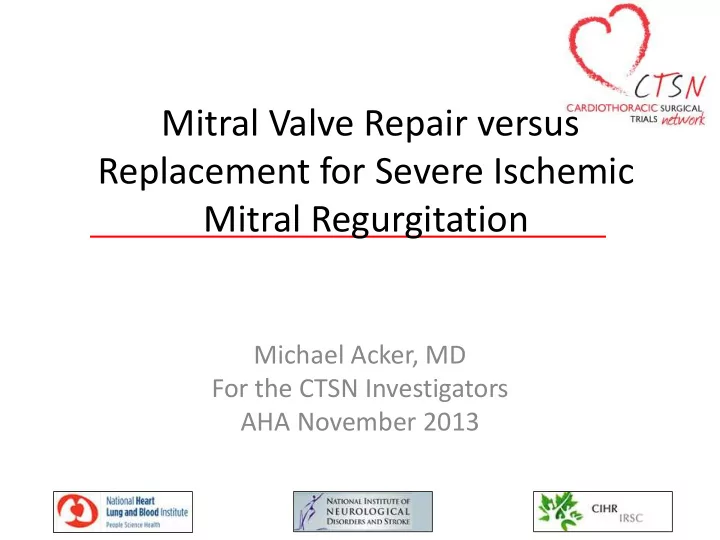

Mitral Valve Repair versus Replacement for Severe Ischemic Mitral Regurgitation Michael Acker, MD For the CTSN Investigators AHA November 2013
Acknowledgements • Supported by U01 HL088942 Cardiothoracic Surgical Trials Network (CTSN) • Funding Agencies: – National Heart Lung and Blood Institute – National Institutes for Neurological Diseases and Stroke – Canadian Institutes for Health Research
Ischemic MR is not Degenerative MV Disease • LV enlarges-loss of elliptical shape; more spherical Mitral annulus dilates • Papillary muscles displace Chordae tether leaflets • Valve leaflets are not in coaptation… = Functional Mitral Regurgitation Annular Dilatation Restricted Leaflets Type I Type IIIb
AHA/ACC and ESC Guidelines No conclusive evidence for superiority of repair or replacement • Class IIb Level C evidence for • Class I Level C evidence for IMR patients severe secondary MR undergoing CAB w/ EF > 30% • Class IIa Level C evidence for IMR patients undergoing CAB w/ EF < 30% • Class IIb Level C evidence for IMR patients not undergoing CAB
Preference for Repair Over Replacement Mitral Repair and Replacement with CABG 70 60 50 Percentage 40 30 20 10 0 Repair Replacement Years 2008-2012, The Adult Cardiac Surgery Database, The Society of Thoracic Surgeons
Treatment Choice is Controversial • Lower periop morbidity and mortality with repair – Vasileva et al, Eur J Cardiothoracic Surg 2011;39:295-303 • Better long-term correction with replacement – Di Salvo et al, J Am Coll Cardiol. 2010; 55:271-82 – Grossi et al, J Thorac Cardiovasc Surg 2001;122:1107-24 – Gillinov et al, J Thorac Cardiovasc Surg 2001;122:1125-41 • Based on retrospective observational studies • Need randomized evidence
SMR Trial Design
Primary Endpoint • Degree of left ventricular reverse remodeling − Assessed by left ventricular end systolic volume index (LVESVI) using TTE at 12 months − Group difference based on Wilcoxon Rank-Sum test with deaths categorized as lowest LVESVI rank • Powered (90%) to detect an improvement of 15mL/m 2 from repair or replacement in LVESVI at 12 months
Secondary Endpoints • Mortality • Recurrent MR • MACCE – Mortality – Stroke – Subsequent MV surgery – HF hospitalization – Increase in NYHA class ≥ 1 • Serious adverse events • Quality of life
Median change in LVESVI Median with 95% CI for change in LVESVI from baseline to 1 yr Z=1.33, p=0.18 Change in LVESVI (mm/m 2 ) (All pts) Repair Replacement Repair Replacement (All pts) (All pts) (Survivors) (Survivors)
Recurrent MR at 1 year Moderate or Severe Recurrent MR 35 32.6 Percent with moderate or severe 30 25 recurrent MR 20 p < 0.001 15 10 5 2.3 0 Repair Replacement
LVESVI with Recurrent MR Mean LVESVI for Patients Undergoing Repair 70 p < 0.001 60 50 Mean LVESVI 40 Baseline 30 12 Months 20 10 0 Repair with MR Repair without MR
Mortality 12 Month Mortality: 14.2% (repair) vs. 17.6% (replacement), p =0.47 30 Day Mortality: 1.6% (repair) vs. 4.0% (replacement), p =0.26
MACCE at 12 Months
Serious Adverse Events 120 Repair Replacement P=NS 100 Overall SAE Rate (100-pt years) 202.1 (repair) vs. 189.0 (replacement) Rate (100/pt-yrs) p=0.49 80 60 40 P=NS P=NS 20 P=NS P=NS P=NS 0
Quality of Life at 1 year 50 Δ =18.4% Δ =16.6% 45 40 35 Mean Score 30 Δ =46.9% 25 Δ =19.6% 20 15 10 5 0 Repair Replacement Repair Replacement SF-12 SF-12 MLHF
NYHA Classification & Death
Limitations • Trial does not include revascularization alone arm – Lack of equipoise with severe MR given current guidelines – Revascularization alone currently studied in ongoing CTSN trial (MMR) • Primary end point measures LV remodeling not a clinical endpoint – Abundant evidence correlates LVESVI with clinical outcomes – Trial with mortality endpoint requires several thousand pts • Only 1 year results reported – Pts will be followed for 2 yrs
Summary • There was no difference in the degree of reverse remodeling and mortality Mortality Repair Replacement 30 day 1.6% 4.0% 1 year 14.3% 17.6% • Significantly more recurrent MR at 1 year (32.6% vs 2.3%) with MV repair compared to chordal sparing MV replacement • No difference in MACCE, overall SAEs, NYHA Class and QOL
Conclusions • Chordal-sparing MV Replacement provides a more durable correction of severe IMR with no differences seen in reversal of LV remodeling or clinical outcomes – MR recurrence may have an important effect on long-term outcomes • Additional follow-up and subset analysis may provide insight about predictors and clinical impact of MR recurrence optimizing therapeutic decisions for individual patients
Investigators • Coordinating Center: InCHOIR • East Carolina Heart Inst • University of Pennsylvania • Brigham and Women's Hospital • Montefiore - Einstein • Ohio State University Medical • Montreal Heart Institute Center • • University of Virginia Health Sacre-Coeur de Montreal System • University of Southern California • Hôpital Laval • Inova Heart & Vascular Institute • Cleveland Clinic Foundation • Mission Hospital • Emory University • NIH Heart Center at Suburban • Columbia University Medical Hospital Center • Jewish Hospital • University of Maryland • Sunnybrook Health Sciences Centre • Baylor Research Institute • Wellstar / Kennestone • Duke University
Recommend
More recommend